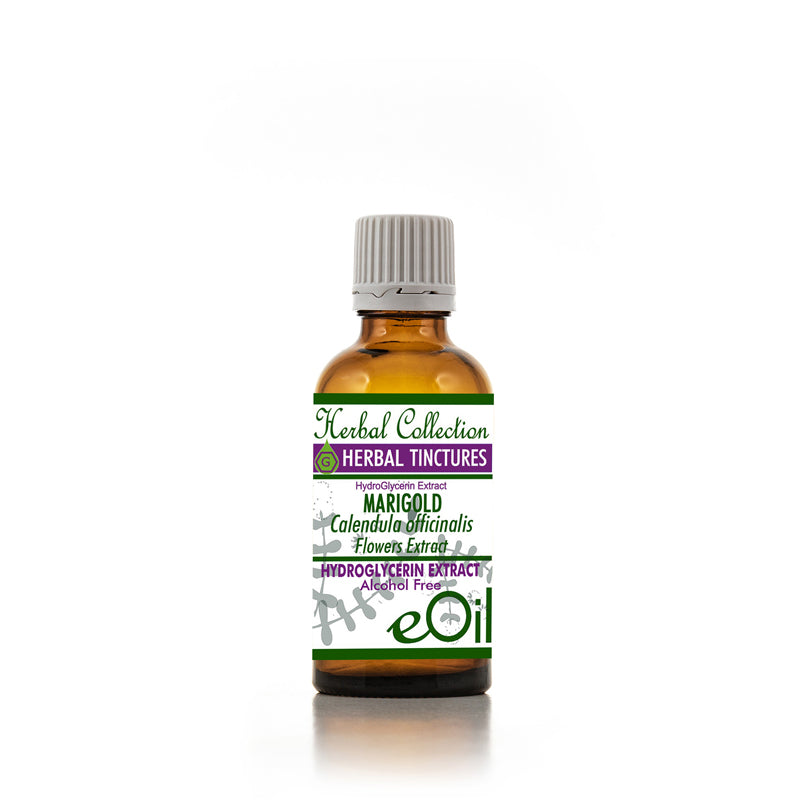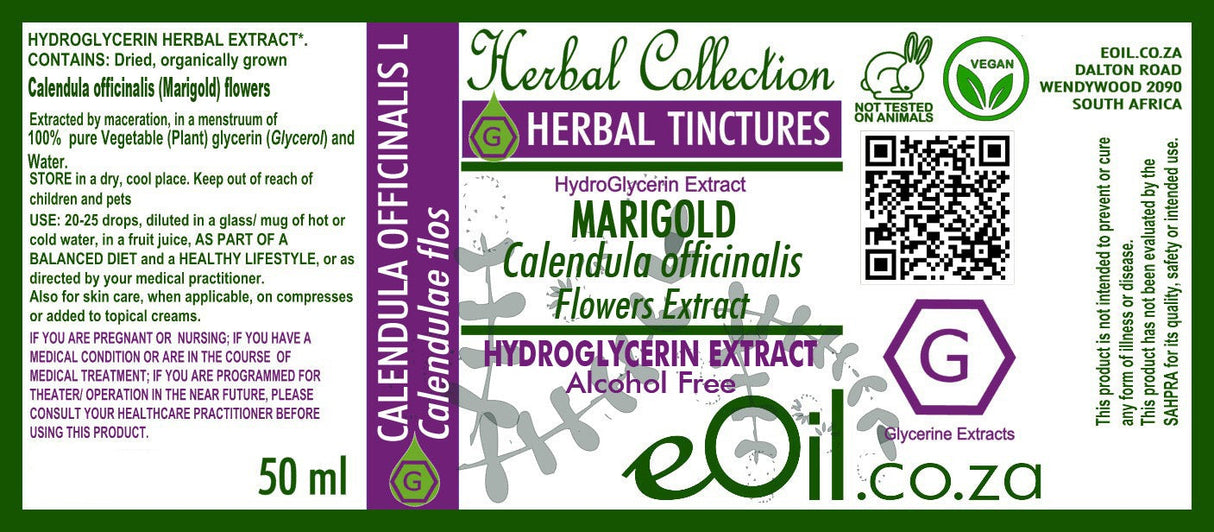Marigold Flowers Liquid Herbal Extract - Vegetable Glycerine
Marigold Flowers Liquid Herbal Extract - Vegetable Glycerine - 50 ML is backordered and will ship as soon as it is back in stock.
Description
Description
Understanding Mother Tinctures & Glycerines
Marigold Flowers Liquid Herbal Extract in vegetable glycerine is crafted from Calendula officinalis blossoms, known for their gentle botanical compounds and traditional wellness uses.
This alcohol-free, vegan-friendly extract preserves calendula’s natural antioxidants in a mild, easy-to-use form.
Ethically sourced and suitable for adults and children, it’s ideal for daily wellness routines
TRADITIONALLY USED FOR
Marigold (Calendula officinalis) Liquid Herbal Extract Tincture & Glycerine | Natural Skin, Immune & Wound Support | eOil.co.za
Unlock the golden healing power of calendula—nature’s gentle skin soother and tissue regenerator.
Our marigold extract is available in both traditional alcohol-based tincture and 100% alcohol-free glycerine for versatile, family-friendly wellness.
Key Benefits
- Powerful Skin Healing: Promotes rapid healing of wounds, burns, cuts, abrasions, rashes, eczema, and post-surgical incisions. Deeply valued for sensitive, inflamed, or troubled skin, and cold sore flare-ups.
- Anti-inflammatory & Antimicrobial: Fights infection, soothes redness, and calms skin irritation—ideal for fungal, bacterial, or viral skin issues and as a gentle option for acne, diaper rash, and after-sun recovery.
- Scar, Varicose & Vein Support: Traditionally used for scars, varicose veins, hemorrhoids, minor swelling, and to aid tissue repair after injury or childbirth.
- Oral, Throat & Digestive Health: Gargle for gum, mouth, or throat healing; soothes oral ulcers, gum inflammation, and mild gastritis or reflux. Used internally for lymph support and to aid menstrual or hormonal balance.
- Gentle for Sensitive Users: Glycerine extract offers an alcohol-free option—safe for children, the elderly, and those sensitive to alcohol extracts.
Dosage & Directions
- Tincture (alcohol-based): Adults, 0.5–1.2 ml (about 10–24 drops) in water 2–3x daily internally, or apply undiluted to wounds/cuts. For oral use, dilute drops in a glass of water and use as a mouthwash/gargle as needed.
- Glycerine extract: Adults/Children, 0.5–1 ml (10–20 drops) in water up to 3x daily, or dab directly to skin for gentle topical application; may be taken by mouth for similar uses as a tincture.
- Always patch test for topical use.
- Not to be used during pregnancy without practitioner advice, and caution if breastfeeding or with allergies to Asteraceae family (daisy, ragweed, etc.).
- Do not combine with heavy sedatives or blood pressure medication without guidance.
- For burns, deep wounds, or infection, consult a healthcare provider.
Cautions & Contraindications
- Rarely may cause allergic rash, especially in those sensitive to daisies/ragweed.
- Avoid internal use in pregnancy due to possible menstruation stimulation.
- Not for use in place of prescription antibiotics for serious infections.
Storage
Store in a cool, dark place, tightly capped and out of children's reach.
Disclaimer
This product is not a substitute for medical advice, especially for chronic or systemic disease. Always consult your doctor for ongoing conditions.
IDENTIFICATION
Calendula officinallis
Area of origin: South America
Certification:
Organic EU; Organic NOP/COR; SAGAP; HACCP
DESCRIPTION
Calendula is the name of species of 15-20 flowering plants from the Asteraceae, daisy, family. Also known as Marigold, the flower has been used as a dye, an ingredient for cooking and as an ingredient for traditional medicine since Ancient Greek times. Its distinctiveness and versatility have led to it developing cultural significance as it is used in the festivals and ceremonies of many cultures. It is cultivated for many culinary uses, for tea and liquor production and for cosmetic and perfumes.
INFORMATION
Source : http://www.wikiphyto.org/wiki/Souci_des_jardins
Reference on http://www.wikiphyto.org
Translation in English by Google Translate (go to the page of the source linked | on Chrome cellphones go on the 3 dots on the top right and select translate in your preferred language | on laptop right click your mouse and select option translate when hoovering on the page
plant name
garden marigold
International Latin denomination
botanical family
Asteraceae
Description and habitat
- Ornamental, aromatic herbaceous plant, native to southern Europe
- Annual or biennial, 30 to 50 cm
- Hairy branching stem
- Broad, lanceolate alternate leaves
- Inflorescences grouped in terminal heads 4 to 7 cm in diameter, composed of numerous orange-yellow ligulate and tubular flowers, which bloom throughout the summer
History and tradition
- The flowers follow the solar curve during the day
Parts used
- flower heads
Dosage forms available
- Mother tincture of flowering tops
Usual dosages
Composition
Main components of the plant
- Essential oil (0.2 - 0.3%) with sesquiterpenes : major component alpha-cadinol (25%), T-cadinol , alpha-ionones and beta-ionones , dihydroactinidiolide
- Triterpene saponosides (2 - 10%): 6 ABCDEF saponosides
- Flavonoids ( quercetol and isorhamnetol )
- Mucilages , phytosterols , carotenoids , taraxasterol , lupeol , beta-amyrin
Main components of buds or young shoots
Main components of essential oil
Properties
Plant properties
- Anti-inflammatory, both orally [1] and topically [2] , antispasmodic
- Astringent, anti-haemorrhagic, healing [3] , anti-edematous [4]
- Stimulates granulocyte formation and phagocytosis, immunostimulant [5]
- Antiasthmatic activity, antihistamine effect, anticholinergic, antispasmodic, mast cell stabilizer [6]
- Used as a remedy for stomach ailments ( lédol , sesquiterpenes , viridiflorol , α-elemol , β-Eudesmol ) [7]
- Decrease in the epithelization phase of wounds and increase in collagen synthesis, decrease in oxidative stress in the skin ( polyphenols , flavonoids , rutin , narcissin ) [8]
- Fungicide, antibacterial, antiviral
- Cytotoxic and antitumor [9] , [10]
- Antimutagen ( saponosides ) [11]
- Potential anti-HIV effect [12]
- Preventive of radiodermatitis and acute dermatitis after irradiation for breast cancer [13] , a Cochrane literature review confirms the efficacy of topical Calendula for the prophylaxis of dermatitis during radiotherapy [14]
Bud properties
Properties of essential oil
Directions
Indications of the whole plant (phytotherapy)
- Wounds, inflammations of the skin and mucous membranes
- Healing delays, bruises, boils
- Dermatitis, leg ulcers
- Pharyngitis
- stomach ulcers
- Psoriasis (?) internally
Indications of the bud (gemmotherapy)
Specific indications of essential oil (aromatherapy)
Known or suspected mode of action
- Saponosides are believed to defend the plant against microbial and fungal attack, and some are immunostimulants
- Saponosides have both a hydrophilic pole (the sugar chain(s)) and a lipophilic hydrophobic pole (the genin), which confers surfactant properties (foam = aphrogenic power), they are generally hypocholesterolemic, induce the secretion of mucus and thin mucus (by vagal reflex)
Usual formulations
Regulations
- French Pharmacopoeia list A (head, flower)
- Activity recognized by the German Commission E
Possible side effects and precautions for use
Bibliographic references
- Go↑ Preethi KC, Kuttan G, Kuttan R. Anti-inflammatory activity of flower extract of Calendula officinalis Linn. and its possible mechanism of action. Indian J Exp Biol. 2009 Feb;47(2):113-20. PMID 19374166
- Go↑ Della Loggia R, Tubaro A, Sosa S, Becker H, Saar S, Isaac O. The role of triterpenoids in the topical anti-inflammatory activity of Calendula officinalis flowers. PlantaMed. 1994 Dec;60(6):516-20. PMID 7809203
- Go↑ Matthew J. Leach. Calendula officinalis and Wound Healing: A Systematic Review. Wounds, Aug 01 2008 (8), http://www.woundsresearch.com/article/9064
- Go↑ Zitterl-Eglseer K, Sosa S, Jurenitsch J, Schubert-Zsilavecz M, Della Loggia R, Tubaro A, Bertoldi M, Franz C. Anti-oedematous activities of the main triterpendiol esters of marigold (Calendula officinalis L.). J Ethnopharmacol. 1997 Jul;57(2):139-44. PMID 9254116
- Go↑ Muley BP, Khadabadi SS, Banarase NB. Phytochemical Constituents and Pharmacological Activities of Calendula officinalis Linn (Asteraceae): A Review. Tropical Journal of Pharmaceutical Research, Vol 8, No 5 (2009) https://www.ajol.info/index.php/tjpr/article/view/48090
- Go↑ Sagar R, Sahoo HB, Kar B, Mishra NK, Mohapatra R, Sarangi SP. Pharmacological evaluation of calendula officinalis L. on bronchial asthma in various experimental animals. Int J Nutr Pharmacol Neurol Dis [serial online] 2014 [cited 2018 Mar 19];4:95-103. Available from: http://www.ijnpnd.com/text.asp?2014/4/2/95/129595
- Go↑ D'Ambrosio M, Ciocarlan A, Colombo E, Guerriero A, Pizza C, Sangiovanni E, Dell'Agli M. Structure and cytotoxic activity of sesquiterpene glycoside esters from Calendula officinalis L.: Studies on the conformation of viridiflorol. Phytochemistry. 2015 Sep;117:1-9. doi: 10.1016/j.phytochem.2015.05.005. PMID 26057223
- Go↑ Fonseca YM, Catini CD, Vicentini FT, Nomizo A, Gerlach RF, Fonseca MJ. Protective effect of Calendula officinalis extract against UVB-induced oxidative stress in skin: evaluation of reduced glutathione levels and matrix metalloproteinase secretion. J Ethnopharmacol. 2010 Feb 17;127(3):596-601. doi: 10.1016/j.jep.2009.12.019. PMID 20026397
- Go↑ Boucaud-Maitre Y, Algernon O, Raynaud J. Cytotoxic and antitumor activity of Calendula officinalis extracts. Pharmazie, 1988, vol. 43, no.3, pp. 220-221 [1]
- Go↑ Jiménez-Medina E, Garcia-Lora A, Paco L, Algarra I, Collado A, Garrido F. A new extract of the plant Calendula officinalis produces a dual in vitro effect: cytotoxic anti-tumor activity and lymphocyte activation. BMC Cancer. 2006 May 5;6:119. PMID 16677386 full text
- Go↑ Elias R, De Méo M, Vidal-Ollivier E, Laget M, Balansard G, Dumenil G. Antimutagenic activity of some saponins isolated from Calendula officinalis L., C. arvensis L. and Hedera helix L. Mutagenesis. 1990 Jul;5(4):327-31. PMID 2204784
- Go↑ Z Kalvachev, R Walder, D Garzaro. Anti-HIV activity of extracts from Calendula officinalis flowers. Biomedicine & Pharmacotherapy, Volume 51, Issue 4, April 1997, Pages 176-180. PMID 9207986
- Go↑ P. Pommier, F. Gomez, MP Sunyach, A. D'Hombres, C. Carrie, X. Montbarbon. Phase III Randomized Trial of Calendula Officinalis Compared With Trolamine for the Prevention of Acute Dermatitis During Irradiation for Breast Cancer. Journal of Clinical Oncology, Vol 22, No 8 (April 15), 2004: p. 1447-1453. PMID 15084618 , full text [2]
- Go↑ Kassab S, Cummings M, Berkovitz S, van Haselen R, Fisher P. Homeopathic medicines for adverse effects of cancer treatments. Cochrane Database System Rev. 2009 Apr 15;(2):CD004845. doi: 10.1002/14651858.CD004845.pub2. PMID 19370613
- Go↑ Ramos A, Edreira A, Vizoso A, Betancourt J, López M, Décalo M. Genotoxicity of an extract of Calendula officinalis L. J Ethnopharmacol. 1998 May;61(1):49-55. PMID 9687081
- Go↑ National Toxicology Program (NTP). Final report on the safety assessment of Calendula officinalis extract and Calendula officinalis. Int J Toxicol. 2001;20 Suppl 2:13-20. PMID 11558637
- Basch E, Bent S, Foppa I, Haskmi S, Kroll D, Mele M, Szapary P, Ulbricht C, Vora M, Yong S; Natural Standard Research Collaboration. Marigold (Calendula officinalis L.): an evidence-based systematic review by the Natural Standard Research Collaboration. J Herb Pharmacother. 2006;6(3-4):135-59. PMID 17317655
CAUTION
Do not use during the first 3 months of pregnancy / breastfeeding
Keep out of reach of children and pets.
As a general rule, always perform a skin patch test before using your essential oils for the first time.
Due to the natural origin of our products, some ingredients may contain trace proteins or allergens, especially in unrefined oils.
We strongly recommend performing a patch test on a small skin area 48 hours before full use to check for sensitivities.
Always dilute essential oils appropriately and follow our recommended usage guidelines to ensure safe application.
If you experience any irritation or allergic reaction, discontinue use immediately and consult a healthcare professional
For more detailed information, please go check this LINK TO Instructions of use essential oils page
DO NOT USE UNDILUTED and SEEK MEDICAL AND SPECIALIST ADVISE WHEN IN DOUBT.
SEE OUR PAGE ON PRECAUTION - HOW TO USE ESSENTIAL OILS SAFELY
This product has not been evaluated by the SAHPRA for its quality, safety or intended use.
For More Information please check our General Safety Herbal products Page

Marigold Flowers Liquid Herbal Extract - Vegetable Glycerine - 50 ML is backordered and will ship as soon as it is back in stock.





